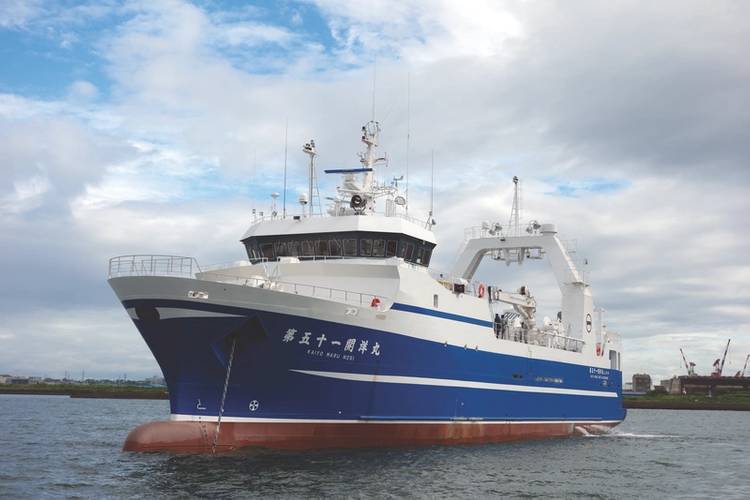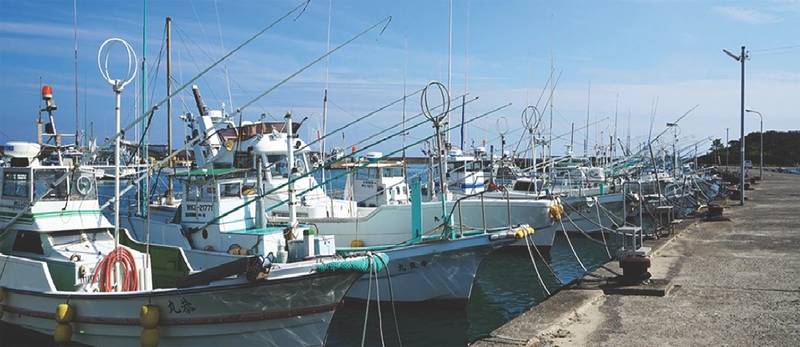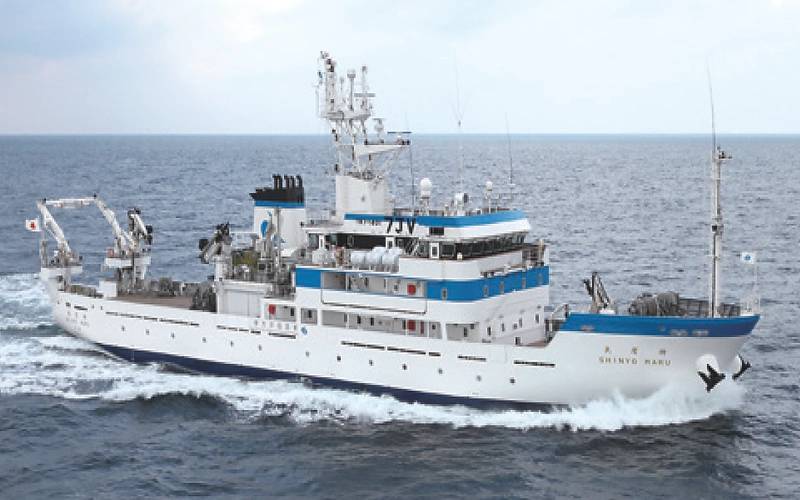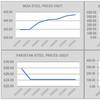“No new fishing vessel has been (added) during the period,” says the email we get from Japan’s largest seafood company, Maruha Nichiro Corp. A year earlier, they had bought shares in New Zealand outfit, Sanford, which had just chartered a Nordic-looking vessel. Seafood rival, Nissui, had just done the same, buying New Zealand and Nordic. That all happened after the Naval Architect’s Society of Japan said a vessel based on the Icelandic design of Reykjavik’s Navis was its Ship of the Year. Expect more of the type, since Miho Shipyard now owns the Navis drawings and is expected to build for more fishing cooperative clients.
One day, there could be more European-looking vessel profiles on that iconic Tokyo Bay scene of Mount Fuji behind tiny, high-prowed, reinforced fiberglass fishing boats (90 percent of the fleet) and the archetypical sloping silhouettes of commercial vessels in the 400 gross-ton, or GT class. Strike that — they’re all commercial vessels, and that iconic photograph is shrinking: 60 percent of the fishery is made up of senior citizens, and that’s a Fisheries Agency fact mirrored in the generally aged population. Pressed by plummeting recruitment in the fisheries sector, Japanese designers and shipyards have started stressing crew comfort — just as Norwegians did when crewing-up to meet their massive, oil-fueled offshore expansion and more recently, when offshore crews returned to the fishery to find crew comforts were “just like offshore”.
Offshore is one of the categories the Japanese fleet and fishing cooperatives are grouped into: the other significant ones are coastal (mostly, those long-foredecked boats) and “overseas”, into which the Navis design falls. “They go aboard several vessels,” says Navis CEO and naval architect, Hjörtur Emilsson, about the Japanese fisheries delegations that have started visiting Iceland. “They’re mostly just interested in the Icelandic way of operating boats and in the European line of fishing vessel.” In the end, the shipyard Miho Shipyard Co. — (or Miho Zosensho) one of Japan’s busiest — built the 600 GT Kaiyo Maru No. 51 using the Navis design. They own the design now and can be expected to build more. “(No. 51) was the first Japanese vessels to be built to Icelandic designs,” Mr. Emilsson says, adding, “It seems to be the beginning.” Icelandic equipment suppliers were also able to sell their wares aboard. A bridge system was sold. Winches and fishing gear were sold. Among the companies involved were Naust Marine, Hampiðjan, Marport and Marel. The Navis design that became The 51st Kaiyo-Maru will be owned by the Hachinohe Fisheries Cooperative Association, one of about a 200 with the clout to buy larger vessels.
First to change
The Maru was the first oceangoing trawler to have been built in Japan in “a quarter century,” judging by United Nations stats.
One disincentive to build new ships has been a buoyant Yen for buying seafood in places like Boston. Another is Japan’s excellent supply chain, especially its range of diesel motor and ships gear makers. Tokyo’s oversight of fisheries and cultural imports, too, has only just slackened. “Many opportunities for Japanese fishing vessel owners can be found (now) that the government there has agreed to have the vessel built in accordance with Icelandic drawings,” says Mr. Emilsson. Japanese delegations that included Fisheries Agency officials, labor groups and ordinary fishermen started arriving in Iceland in 2012, about a year after the devastating Great Eastern Japan Earthquake triggered a tsunami that killed thousands and destroyed countless fishing vessels and their supporting infrastructure. Government financial help prioritized fisheries piers and quays but quickly spread to fishing cooperatives with grants and loans to buy replacements for lost vessels. Others used insurance. Before and since the tsunami, a government program was already ratcheting up payments for energy efficient engines, power plants and fishing gear (10 percent of current subsidy of $1.2 billion, according to a report for the European Union).
Yard activity
Just a handful of Japan’s shipyards — many of which build non-fisheries behemoths — focus on medium-sized fishing boats. Miho Shipyard Co.; Mitsubishi Heavy Industries, or MHI; Marine Hydrtotec Co., or MHT; Mitsui Engineering & Shipbuilding Co., or MES and Niigata Shipbuilding & Repair look to have been the busiest in recent months. They have built about a dozen vessels a year up to 500 GT since the 1990s.
Mitsubishi is fresh from delivering the 64-meter-long 1,000 GT fisheries training vessel, Shinyo Maru, for Tokyo University. A stern trawler in form, the Shinyo Maru will notably help study vessel operations that include trawling, squid jigging and long-line fishing. It’s the fourth Shinyo Maro since the first in 1937, but unlike the others, this one is understood to have two 800 kW electric motors and Dutch acoustic survey equipment below the waterline.
New models
After 50 years in fishing boats and ship hydraulic systems, MHT has upped its range in recent years and is understood to be working on an overseas branch for both vessel design and sales of its ship hydraulics. There’s already a maintenance operation at Busan, Korea; parts distribution at Dalian, China and a sales presence in Taiwan. This designer-builder’s most modern machining and welding is at its workshops in Shimonoseki, and MHT clients include the Japanese navy. MHT designs include range in size from 350 GT to 2,200 GT American purse-seiners to 90 GT Japanese-style seiners to offshore stern trawlers of from 65 GT to 160 GT. The American trawlers come with a tall, ABA FLEX crane to assist in hauling catch. For the 3,496 GT seiner, MHT makes two winch types: a choker winch and a three-drum purse winch.
There are more of the Japanese-style seiners in the Sea of Japan and the Northeast Pacific than the American, perhaps because the Japanese style of seining is a team operation of several vessels holding a line that’s a good fit for the fishing cooperatives. All MHT Japanese-style seiners appear to come with double purse winches and a powerful crane, all made by MHT and all ISO9001-certified. Four other trawler types bear the distinctly pointed prows and sloping sides that emerged in Japan in the 1930’s.
Niigata built the heavily photographed 88th Koyo Maru late in 2016, and the 760 GT vessel bears some of the new marks of Japanese fishing boats. Apart from doing nearly 18 knots, Tokai Fishery Co.’s 69 m, round-haul netter boasts a power management system and is reportedly safer and less labor-intensive to run than other, similarly sized vessels. These attributes garner grants and loans under the government’s “better management” subsidy. The 2,942 kW units aboard the Navis-type Kaiyu Maru 51 also qualify for loans and grants for being energy efficient and meeting Tier II emissions strictures.
Engineering outfit MES holds the pulse of Japanese shipbuilding and is building about 180 MAN B&W low-speed diesel engines a year, all of them at the Tamano Works Machinery Factory. The company’s record of installed horsepower and the Fisheries Agency both confirm the power quotient of Japanese vessels is on the rise (stat here). A pact since 1926 with MAN Diesel & Turbo has also served them well.
Ocean currents from the north and south meet both east and west of Japan, and the fronts create “a fish magnet … a huge feeding ground,” wrote Masaki Sato in a UN report back in 1996. Since then, species counts have shrunken from one-twentieth to one half, and it’s part of the reason there are fewer boats and the need for vessels that attract recruits.




















